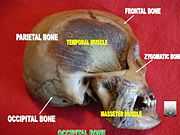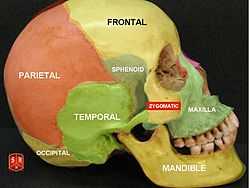The occipital bone //, a saucer-shaped membrane bone situated at the back and lower part of the skull, is trapezoidal in shape and curved on itself. It is pierced by a large oval opening, the foramen magnum, through which the cranial cavity communicates with the vertebral canal.
Structure
The occipital, like the other cranial has outer and inner tables, between which is the cancellous tissue or diploë; the bone is especially thick at the ridges, protuberances, condyles, and anterior part of the basilar part; in the inferior fossæ it is thin, semitransparent, and destitute of diploë.
| Outer surface of occipital bone. |
| Inner surface of occipital bone. |
|
Foramen magnum
The foramen magnum (Latin for large hole) is a large oval aperture with its long diameter antero-posterior; it is wider behind than in front where it is encroached upon by the condyles .
It transmits the medulla oblongata and its membranes, the accessory nerves, the vertebral arteries, the anterior and posterior spinal arteries, and the membrana tectoria and alar ligaments .
Angles
The superior angle of the occipital bone articulates with the occipital angles of the parietal bones and, in the fetal skull, corresponds in position with the posterior fontanelle.
The inferior angle is fused with the body of the sphenoid. The lateral angles are situated at the extremities of the grooves for the transverse sinuses: each is received into the interval between the mastoid angle of the parietal and the mastoid part of the temporal.
Borders
The superior borders extend from the superior to the lateral angles: they are deeply serrated for articulation with the occipital borders of the parietals, and form by this union the lambdoidal suture.
The inferior borders extend from the lateral angles to the inferior angle; the upper half of each articulates with the mastoid portion of the corresponding temporal, the lower half with the petrous part of the same bone.
These two portions of the inferior border are separated from one another by the jugular process, the notch on the anterior surface of which forms the posterior part of the jugular foramen.
Development

Figure 3 : Occipital bone at birth.
The planum occipitale [Fig. 3] of the squama of the occipital bone is developed in membrane, and may remain separate throughout life when it constitutes the interparietal bone; the rest of the bone is developed in cartilage.
The number of nuclei for the planum occipitale is usually given as four, two appearing near the middle line about the second month, and two some little distance from the middle line about the third month of fetal life.
The planum nuchale of the squama is ossified from two centers, which appear about the seventh week of fetal life and soon unite to form a single piece.
Union of the upper and lower portions of the squama takes place in the third month of fetal life.
An occasional center (Kerckring) appears in the posterior margin of the foramen magnum during the fifth month; this forms a separate ossicle (sometimes double) which unites with the rest of the squama before birth.
Each of the lateral parts begins to ossify from a single center during the eighth week of fetal life. The basilar portion is ossified from two centers, one in front of the other; these appear about the sixth week of fetal life and rapidly coalesce.
Mall states that the planum occipitale is ossified from two centers and the basilar portion from one.
About the fourth year the squama and the two lateral portions unite, and about the sixth year the bone consists of a single piece. Between the 18th and 25th years the occipital and sphenoid become united, forming a single bone.
In other animals
In many animals these parts stay separate through life; e.g. in the dog as four parts: supraoccipital (= the squama); left and right exoccipital (= the lateral parts); basioccipital (= the basilar part).
The occipital bone is part of the endocranium, the most basal portion of the skull. In Chondrichthyes and Agnathans, the occipital do not form as a separate element, but remain part of the chondrocranium throughout life. In most higher vertebrates, the foramen magnum is surrounded by a ring of four bones. The basioccipital lies in front of the opening, the two exoccipitals lie to either side, and the larger supraoccipital lies to the posterior, and forms at least part of the rear of the cranium. In many bony fish and amphibians, the supraoccipital is never ossified, and remains as cartilage throughout life. In primitive forms the basioccipital and exoccipitals somewhat resemble the centrum and neural arches of a vertebra, and form in a similar manner in the embryo. Together, these latter bones usually form a single concave circular condyle for the articulation of the first vertebra.[1]
In mammals, however, the condyle has divided in two, a pattern otherwise seen only in a few amphibians. Most mammals also have a single fused occipital bone, formed from the four separate elements around the foramen magnum, along with the paired postparietal bones that form the rear of the cranial roof in other vertebrates.[1]
Additional images
| Position of occipital bone (shown in green). Animation. |
| Shape of occipital bone, seen from above. |
| Sagittal section of skull. (Occipital bone is at right, in blue.) |
| Base of the skull. Upper surface. (Occipital bone is at bottom, in blue.) |
| Base of skull. Inferior surface. |
| Membrana tectoria, transverse, and alar ligaments. |
| Median sagittal section through the occipital bone and first three cervical vertebræ. |
| Muscles connecting the upper extremity to the vertebral column. |
| Upper part of medulla spinalis and hind- and mid-brains; posterior aspect, exposed in situ. |
| Muscles of the pharynx, viewed from behind, together with the associated vessels and nerves. |
| Internal occipital protuberance |
| External occipital protuberance |
| Cephalic extremity.Original mummification. |
|
See also
- This article uses anatomical terminology; for an overview, see anatomical terminology.
References
This article incorporates text in the public domain from the 20th edition of Gray's Anatomy (1918)
- ↑ 1.0 1.1 Romer, Alfred Sherwood; Parsons, Thomas S. (1977). The Vertebrate Body. Philadelphia, PA: Holt-Saunders International. pp. 221–244. ISBN 0-03-910284-X.
|
|---|
| | Occipital | |
|---|
| | Parietal | |
|---|
| | Frontal | |
|---|
| | Temporal | |
|---|
| | Sphenoid | |
|---|
| | Ethmoid | |
|---|
| |
|---|
| | Description |
- Anatomy
- bones
- skull
- face
- neurocranium
- compound structures
- foramina
- upper extremity
- torso
- pelvis
- lower extremity
- Physiology
- Development
- Cells
|
|---|
| | Disease |
- Congenital
- Neoplasms and cancer
- Trauma
- Other
- Symptoms and signs
|
|---|
| | Treatment | |
|---|
|
|






























